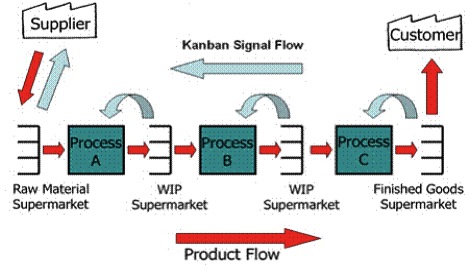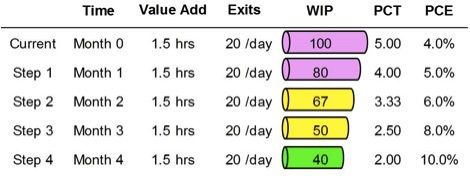Lean Six Sigma is a leadership methodology that significantly improves process quality, speed, costs, and agility. One of the concepts applied is called a pull system, and in this article Steven Bonacorsi explains how to design one for your process. Doing so will help you to stabilize a process flow into a predictable work control system.
Lean Six Sigma is a leadership methodology that significantly improves process quality, speed, costs, and agility. Practitioners leverage many tools and methods to transform a current state process into a stabilized future state. These techniques are essential when you are designing and implementing a workflow automation tool. One of the concepts applied is called a pull system and it is very different from the push system models from which we are often changing.
Push systems assign work without regard for whether or not the resource is available, which obviously can be a problem when new tasks are assigned to a resource that is already overloaded with work. This article will show you how to design a pull system for your process. Pull systems are more practical and, as you are about to learn, much more efficient and enhance productivity. Let’s look at how to understand a Lean Six Sigma Pull System.
The following definitions will be used to describe the speed, efficiency, throughput (exit rate), and capacity of a process:
Process Cycle Time (PCT): The time from release of a product into a process until its completion. Also called Process Lead Time (PLT)
Example: The elapsed time from when a new mobile phone customer calls to when the new mobile account is setup averages fourteen days.
Work-in-Process (WIP): Product, service, or transaction that is within the process boundaries. It is the unit moving through the process. As the WIP moves through the process, it will change in fit, form, or function as it is transformed into the final output that the customer receives.
Example: There were 3,000 refinance applications in process at month’s end.
Exit Rate (Throughput): The process output over a defined period of time
Example: The process closed one hundred new mobile accounts per day last month.
Why Use a Pull System?
- Pull systems limit the amount of “stuff in process” in order to control the process cycle time.
- Pull systems help to stabilize processes to make it easier to apply analysis and improvement tools.
- To control and reduce the amount of product or information in process, allowing a sharper focus on problem areas with less “stuff” to get in the way of analysis efforts.
- To control and reduce cycle time to generate faster feedback cycles on improvement projects, which also increases the process speed and, thus, cycles of learning.
- The primary goals of a work control system are to stabilize then reduce process cycle time and cycle time variability.
- Pull systems are agile, faster, and predictable.
Governing Principle of Pull Systems: Start Rate = Exit Rate
Pull systems require that you start new work at a rate that matches the completion of existing work. This means that the start rate should always be equal to the exit (or completion) rate. Cycle time fluctuates with the amount of WIP.
Pull System Benefits
Efficiency: A pull system can attain the same throughput as a push system with less average WIP and, therefore, a shorter cycle time.
Productivity: Less WIP means less “stuff” to get in the way, and thus more time spent adding value to the process.
Ease of Control: Pull systems rely on setting easily controllable WIP levels, creating a much more manageable process.
Quality Improvement: Low WIP and associated cycle time systems are more sensitive to quality and, therefore, force problem resolution. These systems facilitate quality by improving feedback and learning cycles.
How to Size a Pull System
Step 1: Determine the Current Process Cycle Time (PCT)
Process Cycle Time (PCT) is the time from the release of a product, service, or transaction into a process (process start) until its completion (process end). PCT can be approximated using Little’s Law:
PCT=WIP/EXIT RATE
WIP is the number of things in process at any given time. WIP is not inventory. Inventory changes into WIP once it passes the start time of the process, and remains WIP until it reaches the stop time of a process. Once the WIP has exited the process, it changes from work in process into a finished product, service, or transaction that the customer will receive.
Exit rate (also known as throughput) is the amount of work (product/service/transaction) completed over a given period of time. The exit rate should equal the customer demand of the process for that given period of time.
Example of Process Cycle Time is: PCT = 100 orders/20 orders per day = 5 days
Step 2: Determine the Current Process Cycle Efficiency (PCE%)
Process Cycle Efficiency (PCE%) is a measure of the relative efficiency in a process. PCE represents the percentage of customer value-add time, which is the time the product, service, or transaction changes in form, fit, or function toward completion:
PCE%=(CUSTOMER VALUE-ADD TIME/PCT)(100)
Process Cycle Efficiency (PCE) is the performance indicator for a Pull System, although some people find it more intuitive to understand PCT as a percent or PCE%.
Example: Calculating Current Process Cycle Efficiency (PCE)
PCT = 5 days (40 hours)
CVA = 1.5 hours
PCE% = (1.5 hours/40 hours)(100) = 3.75%
Step 3: Determine Target PCE
Target process cycle efficiency (PCE) is selected by the process improvement team.
Rules of Thumb:
- If the current PCE is lower than 10 percent, then set the target PCE to 10 percent to be conservative.
- If the current PCE is between 10 and 25 percent, then set the target PCE to 25 percent.
- If the current PCE is greater than 25 percent, then you can strive for achieving the highest quality target known as World Class. To reach this level you would set the target PCE to the world-class level of 50 percent.
The target PCE% is where you need or want the process to be in the future. We may not achieve the target PCE immediately, and often we need to walk before we run, meaning, we will need to slowly reduce the WIP to optimize the process to the target PCE%. We will discuss this later under managing the release logic of a pull system.
Example of Target Process Cycle Efficiency (PCE) is:
PCT = 5 days (40 hours)
CVA = 1.5 hours
PCE = 1.5 hours/40 hours = 3.75%
Target PCE% = 10% from current state 3.75% (assuming 40 hour week)
Step 4: Calculate Theoretical Best PCT
Theoretical Best PCT is the “best” or lowest process cycle time achievable based on the process characteristics. It is measured as:
PCTTB=CVA TIME\TARGET PCE
CVA is the customer value-addtime only along the critical path. It does not include the value-add time of parallel process steps.
Example of How to Calculate Theoretical Best PCT:
PCT = 5 days (40 hours)
CVA = 1.5 hours
PCE = 1.5 hours/40 hours = 3.75%
PCTTB is: PCTTB = 1.5 hours/0.1 = 15 hours = 2.0 days
*Note: 0.1 used to convert the 10% to a decimal.
Now we know that with 1.5 hours of CVT and a PCE of 10 percent, the PCT will take two days (fifteen hours) versus five days in the current state.
Step 5: Calculate the WIP Cap
The WIP cap determines the maximum WIP allowed within the process at any time. WIP cap is measured as:
WIP CAP = PCTTB x EXIT RATE
WIP Cap = Work In Process Capacity
PCT = Process Cycle Efficiency
Exit Rate = Throughput = Yield (Good = No Rework)
TB = Theoretical Best
Example of how to Calculate WIP CAP:
PCT = Process Cycle Time = 5 days (40 hours)
CVA = Customer Value Add = 1.5 hours
PCE = 1.5 hours/40 hours = 3.75%
PCTTB = 1.5 hours/0.1 = 15 hours = 2.0 days
WIP Cap = 2.0 days x 20 orders/day = 40 orders
Just remember that you can’t go from “beginning” to “desired” immediately, you have to step into it at a reasonable pace.
How to Release WIP into a Pull System
1. Count the WIP in your process
2. Determine if you can release work or not
- If the WIP > WIP Cap, do not release any more work
- If the WIP < WIP Cap, release enough work to get to the WIP Cap or slightly above.

The product naturally flows from raw materials to work-in-progress to finished goods.
Release Logic for Pull Systems Requires Discipline

Typically the current Work in Process (WIP) level will be significantly greater than the WIP Cap level. Therefore, a plan must be developed to reduce the WIP slowly. This requires the discipline to iteratively improve processes by reducing the amount of work in progress. For a workflow automation system, this could mean that you avoid assigning more than one ticket to a specific technical resource.
Managing Backlog and Queues with Pull Systems
Two fundamental questions arise for pull systems:
1. How do I manage the backlog of work that needs to start in my process?
2. How do I manage the work at each process step to keep from overloading any individual step?
Managing a backlog involves assigning tasks or workitems that can be processed in an efficient. Most help desks implement a mechanism to handle requests in an orderly fashion or what is often called a queue.
Queue management addresses:
- The priority in which work is to be processed (started) into the process from the input queue (backlog)
- How the pull system limits the size of the allowable input queue for downstream process steps (helps improve flow by not overloading downstream steps).
- One of the primary benefits of pull systems is the ability to provide the customer with an accurate and precise promise date/time based upon the amount of backlog in front of the process.
For example, the WIP cap on a mortgage refinancing process is set at 1,000 applications, providing a consistent cycle time of twenty days with low variability.
If the backlog of unprocessed mortgage applications grows due to increased customer demand for refinancing, then the close date can be accurately and precisely estimated by simply using the number of orders in the backlog plus the WIP cap.
In addition, work can be expedited through the process by simply changing the prioritization of the mortgage applications in the backlog, without ever having to touch the process (meaning we don’t have to track down mortgage applications mid-process and reshuffle the work priority!)
The pull systems will provide management with a much better look at the need to flex capacity to meet changing demand.
If the backlog begins to grow, additional resources can be added to increase the exit rate (and WIP cap proportionally) to maintain the same cycle time.
Pull system queue prioritization methods
Queue management answers the second question “What to work on first?” Each step in the process will typically have work waiting to be processed (at least until the process can be improved to a one-piece or single-piece flow).
Inevitably, this work must be prioritized—the most effective method for this is first-in, first-out (FIFO). FIFO means just that: Whatever came in first gets processed first. In this way, the oldest stuff in process is the stuff that gets worked on first, ensuring that nothing sits around.
An alternate method can be used if parallel process steps exist: If one step becomes overloaded (input queue grows), then work can be moved to another step or resources can be added or shifted intelligently to the overloaded process step to reduce the queue.
In Summary
A pull system is a Lean Six Sigma method used to stabilize a process flow into a predictable work control system. Once a pull system has been established across the entire process, additional Lean Six Sigma concepts can be applied, including line-balancing, kanban, takt rate boards, 5s, cross-training, visual metrics, and statistical process controls. The next time that you design and implement workflow automation, consider designing the logic of the task assignment engine with these principles in mind. You will find your entire team benefits from a smarter way to assign and manage work!

